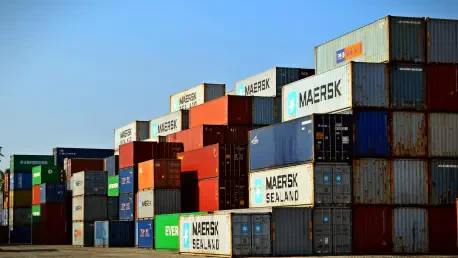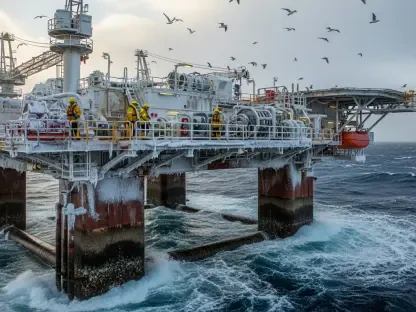Setting the Stage for a Climate Policy Setback
The global shipping industry, responsible for transporting over 80% of world trade, stands at a critical juncture as it grapples with its role in climate change, contributing nearly 3% of global greenhouse gas emissions—equivalent to one billion metric tons of carbon dioxide annually. A landmark opportunity to curb this impact through a legally binding carbon tax under the International Maritime Organization’s (IMO) Net-Zero Framework has recently crumbled under opposition led by the United States and oil-producing nations. This failure reverberates across markets, affecting shipping companies, fuel suppliers, and environmental technology sectors. This market analysis delves into the implications of the stalled policy, examining current trends in the shipping industry, economic ripple effects, and projections for decarbonization efforts, while offering strategic insights for stakeholders navigating this turbulent landscape.
Diving into Market Trends and Economic Dynamics
Current State of Shipping Emissions and Regulatory Pressure
The shipping sector remains a cornerstone of global commerce but also a significant pollutant, with emissions projected to potentially account for up to 17% of global greenhouse gases by 2050 if left unchecked, according to industry estimates. The IMO’s ambitious target to slash emissions by 50% by 2050 compared to 2008 levels has driven regulatory focus, with the now-stalled Net-Zero Framework aiming for a 17% reduction by 2028 through carbon pricing. Currently, the absence of this mechanism leaves the market reliant on voluntary measures and fragmented regional policies, creating uncertainty for shipping operators. Many firms hesitate to invest in cleaner technologies without clear global mandates, slowing the adoption of alternative fuels like green hydrogen or ammonia.
Economic Fallout from Policy Delay
Opposition to the carbon tax, spearheaded by the United States alongside Saudi Arabia and Russia, reflects a prioritization of short-term economic stability over environmental goals, significantly impacting market dynamics. The decision to delay the framework until 2026, following a tight vote at the IMO’s Marine Environment Protection Committee, shields shipping companies from immediate cost increases associated with carbon penalties. However, this reprieve comes at the expense of long-term planning, as firms face uncertainty regarding future compliance costs. For fuel suppliers, particularly those invested in heavy fuel oil, the delay sustains demand for traditional products while stunting growth for innovators in low-carbon alternatives. Investors in green tech sectors may see reduced momentum, as policy inertia discourages capital allocation toward sustainable maritime solutions.
Global Market Divisions and Competitive Implications
The split among the IMO’s 175 member states reveals stark disparities in market readiness for decarbonization. Developing nations, concerned about bearing disproportionate transition costs, align with delaying tactics, while environmentally proactive regions push for faster action. This fragmentation creates uneven competitive landscapes—shipping firms in stricter regulatory zones may face higher operational costs compared to counterparts in lenient markets. Additionally, ports and logistics hubs in progressive areas could lose business to competitors in regions with laxer standards, skewing trade flows. The geopolitical tension, mirrored in broader climate negotiations, suggests that market players must prepare for a patchwork of regulations rather than a unified global standard in the near term.
Forecasting the Future of Shipping Decarbonization
Projected Emission Trajectories and Market Risks
Looking ahead, the delay in implementing a global carbon tax poses substantial risks to emission reduction targets. Without immediate policy intervention, the shipping industry’s carbon footprint could spiral, complicating efforts to meet the IMO’s 2030 goal of a 30% emissions cut. Market projections indicate that each year of inaction entrenches outdated infrastructure, given that vessels often operate for over 25 years. For stakeholders, this translates to heightened exposure to future regulatory shocks when policies inevitably tighten. Companies that fail to anticipate these shifts risk stranded assets and obsolescence, particularly as public and investor scrutiny of environmental performance intensifies.
Emerging Opportunities in Technology and Regulation
Despite the setback, market opportunities are emerging through technological innovation and incremental regulatory steps. The IMO’s upcoming revision of the Carbon Intensity Indicator (CII), a measure of operational efficiency, slated for discussion in the coming months, could enforce stricter standards and drive near-term emission cuts. Investments in fuel efficiency technologies and alternative energy sources like methanol are gaining traction, offering shipping firms a chance to differentiate themselves. Moreover, market-driven initiatives, such as green shipping corridors and carbon offset programs, are likely to grow as companies seek to mitigate risks and appeal to eco-conscious clients. These trends suggest a gradual shift toward sustainability, even in the absence of a global tax.
Long-Term Market Shifts and Strategic Positioning
Over the next few years, from 2025 to 2028, the shipping market is expected to witness a slow but steady pivot toward decarbonization, contingent on resumed IMO discussions in 2026. Analysts predict that while a comprehensive carbon tax may not materialize until 2028, interim measures and regional policies will shape competitive dynamics. Shipping giants with the foresight to invest in cleaner fleets now could secure first-mover advantages, capturing market share as regulations tighten. Conversely, laggards may face escalating costs and reputational damage. For fuel providers, diversifying into low-carbon options remains critical to hedge against declining demand for fossil-based products, aligning with broader energy transition trends.
Reflecting on Market Implications and Strategic Pathways
Looking back, the collapse of the global shipping carbon tax under US-led opposition marked a pivotal moment that exposed the fragility of international consensus on climate action within the maritime sector. The delay not only deferred critical emission reductions but also reshaped market expectations, leaving shipping companies and related industries in a state of limbo. However, this setback illuminated pathways for resilience—stakeholders adapted by exploring technological innovations and preparing for incremental regulatory shifts. Moving forward, businesses should prioritize investments in fuel efficiency and alternative energy to stay ahead of future mandates. Policymakers must develop support mechanisms for vulnerable markets to ensure equitable transitions. Meanwhile, fostering collaboration across regions can help bridge competitive divides, paving the way for a more sustainable maritime industry in the years ahead.









